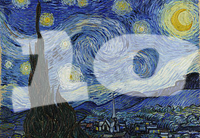
Update From Brett
Top Ten Things I Wish We'd Build

When you gaze into that Starry Night, what ten things can YOU think of?
As I talked about at the Kickoff, I want us to have an expansive view of our individual roles and what UTS could do for the university. The possibilities are as wide as the horizon and I believe that for those who want to be creative and challenge themselves, there is a way to chart your own course or paint your own picture. This year, I'm hoping to do that through investing in people who want to use analysis, science, math, and engineering to take their job to the next level.
I chose the painting Starry Night to suggest that the view of the night sky does not have to be limited to the black and white of space and stars and it does not have to evoke the loneliness of deep distances, feeble gravity, or penetrating cold. Instead, while science governs the stars there is a view of the sky that sees beauty, flow, and connection. An analytical view of your work is not disconnected or dispassionate. It is simply your work seen in new ways through new eyes.
One of the topics that is causing all sorts of trouble for UTS is the notion of location. There is no good record of where things are and there isn't anybody in the institution that has a plan to change that. But I think it would be great if someone wrote a mobile app that would read your GPS location and allow you to record that as your office location. Think of it as a FourSquare for enterprise location mapping. With such an app, information could be associated with existing floor plans and used for billing purposes to answer questions we have to ask all the time: where are you; which phone jack are you using; what building are you in?
Or similarly, why aren't we using Google Maps for way finding inside our buildings? Anybody can freely upload floor plans to Google Maps and associate the interior mapping of a building with Google's existing exterior view. Then, if you want to find your way to a specific wing of the Hospital or to a specific classroom in the Psychology building, you could get walking directions door to door. Google will even help you if you have lots of blueprints to upload and mark.
Here are eight other things I wish we would build:
- A way to predict how many bugs we will find during application testing
- Any iPhone or android app that makes someone's life easier or mobilizes any part of your job
- A way to predict traffic loads on our services so that we can predict outages and slowdowns before they happen
- A seasonally adjusted model for staffing levels needed at the service desk or desktop support
- A better way to know when we have "network blips" - I hate it when that gets used as an excuse
- Predictive models to anticipate what a student's grade will be before they take the class
- A neural network for classifying the state of our wireless network
- A mechanism for open communication between IT and the students
We are better prepared to innovate than we think. Often the challenge is being willing to try something new. According to a recent outstanding article at Fast Company, a technology website, a non-profit CEO, Angela Blanchard, says that these days when she meets promising job candidates, they are often forthright about their limitations. "They'll say, 'I'm not trained for this,'" Blanchard notes. Her response to them: "Well, no one is." Increasingly, she says, the most important jobs are what she calls "FIO jobs": "Figure it out. That is the job," she tells them.
So I challenge each of us to look at projects on the horizon and get involved. We can talk to our managers about our career development. We can connect with our customers to come up with new and innovative things. We can take a stab at this list or think of some of our own. Don't be afraid to take a walk some starry night and find some inspiration.
- Brett Coryell, Deputy CIO, UTS